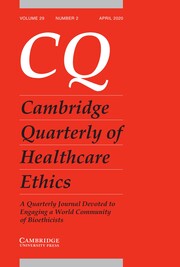Article contents
What Health Science Students Learn from Playing a StandardizedPatient in an Ethics Course
Published online by Cambridge University Press: 18 August 2010
Extract
Formal teaching of ethics in health science programs at the entry level andpostprofessional level in the United States and Canada has been documented inthe professional literature for more than 30 years, yet there are significantdifferences in the way it is taught and how much time is devoted to the subject.Numerous teaching and evaluation methods have been used in ethics education,such as lectures, written examinations, debates, role-playing, small groupdiscussion, and case study analysis. Most instruction in ethics in the healthsciences has been geared toward ethical analysis of case studies, that is, thestudent is asked to read a case or discuss a case with others, identify theethical issues verbally or in writing, propose different resolutions supportedby principles and theory, and select the best course of action. Yet, analysis ofa case is an unlikely route to develop skills in coping with the uncertainty andemotional nature of ethical issues commonly encountered in clinical practice,nor does it give us an indication of what students would “reallydo” when they encounter an actual ethical problem.
Information
- Type
- Special Section: Bioethics Education
- Information
- Copyright
- Copyright © Cambridge University Press 2010
References
1. Doukas, DJ . Where is the virtue in professionalism? Cambridge Quarterly of Healthcare Ethics 2007;12:147–54.Google ScholarPubMed
2. Haddad, A, Kaatz, B, McCart, G, McCarthy, R, Pink, L, Richardson, J. Report of the ethics course content committee: Curricular guidelines in pharmacy education. American Journal of Pharmacy Education 1993;57(Wintersuppl.):34S–43S.Google Scholar
3. Nagoshi, MH . Role of standardized patients in medical education. Hawaii Medical Journal 2001;60(12):323–4.Google ScholarPubMed
4. Barrows, HS . An overview of the uses of standardized patients for teaching and evaluating clinical skills. Academic Medicine 1993;68(6):443–51CrossRefGoogle ScholarPubMed; Colliver, JA, Swartz, MH. Assessing clinical performance with standardized patients. Journal of the American Medical Association 1997;278:790–1.Google ScholarPubMed
5. Emerging Trends in the Use of Standardized Patients. Contemporary Issues in Medical Education Data Brief. AAMC, May 1998, Vol. 1, Number 7; McGraw, RC, O’Connor, HM. Standardized patients in the early acquisition of clinical skills. Medical Education 1999;33:572–8CrossRefGoogle ScholarPubMed; Smith, SR, Dollase, RH, Boss, JA. Assessing students’ performances in a competency-based curriculum. Academic Medicine 2003;78(1):97–107.CrossRefGoogle Scholar
6. Monaghan, MS, Gardner, SF, Hastings, JK, Reinhardt, GL, Knoll, KR, Vanderbush, RE, Cantrell, M. Student attitudes toward the use of standardized patients in a communication course. American Journal of Pharmaceutical Education 1997;61:131–136Google Scholar; Gibbons, SW, Adamo, G, Padden, D, Ricciardi, R, Graziano, M, Levine, E, Hawkins, R. Clinical evaluation in advanced practice nursing education: Using standardized patients in health assessment. Journal of Nursing Education 2002;41(5):215–21Google ScholarPubMed; Vessey, JA, Huss, K. Using standardized patients in advanced practice nursing education. Journal of Professional Nursing 2002;18(1):29–35CrossRefGoogle ScholarPubMed.
7. See note 5, Smith et al. 2003:100.
8. Triola, M, Feldman, H, Kalet, AL, Zabar, S, Kachur, EK, Gillespie, C, et al. . A randomized trial of teaching clinical skills using virtual and live standardized patients. Journal of General Internal Medicine 2006;21:424–9 at p. 424CrossRefGoogle ScholarPubMed.
9. Haddad, A . Leading students to care: Use of clinical simulations in ethics. Journal of Pharmacy Teaching 2005;12(1):61–79CrossRefGoogle Scholar; Haddad, A . Teaching for enduring understanding in ethics. Journal of Physical Therapy Education 2005;19(3):73–7Google Scholar.
- 14
- Cited by

